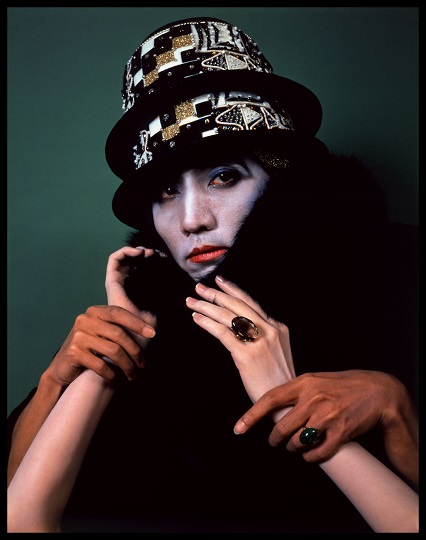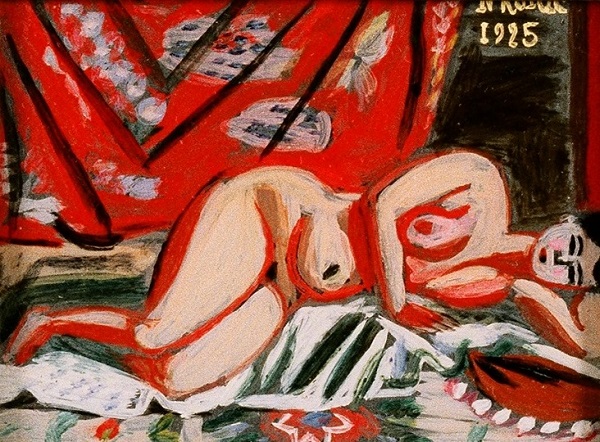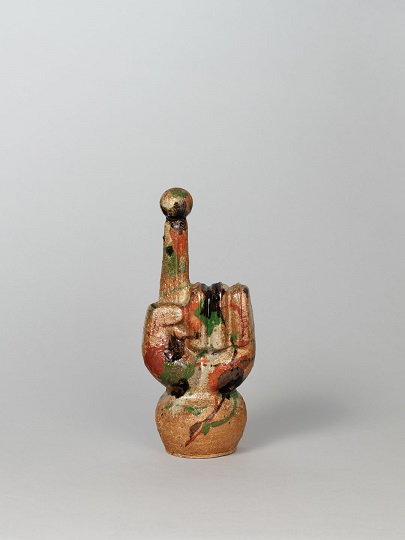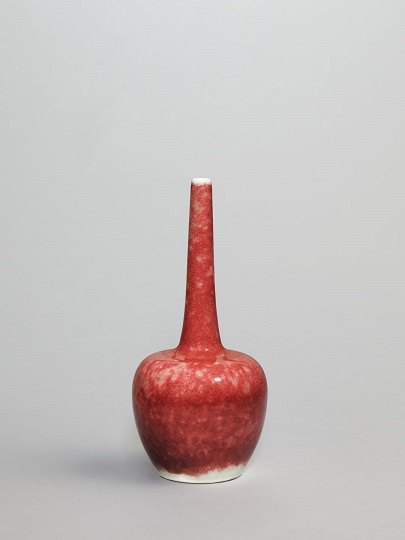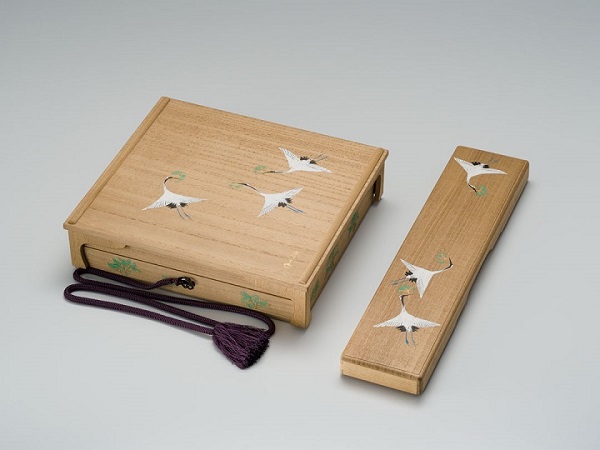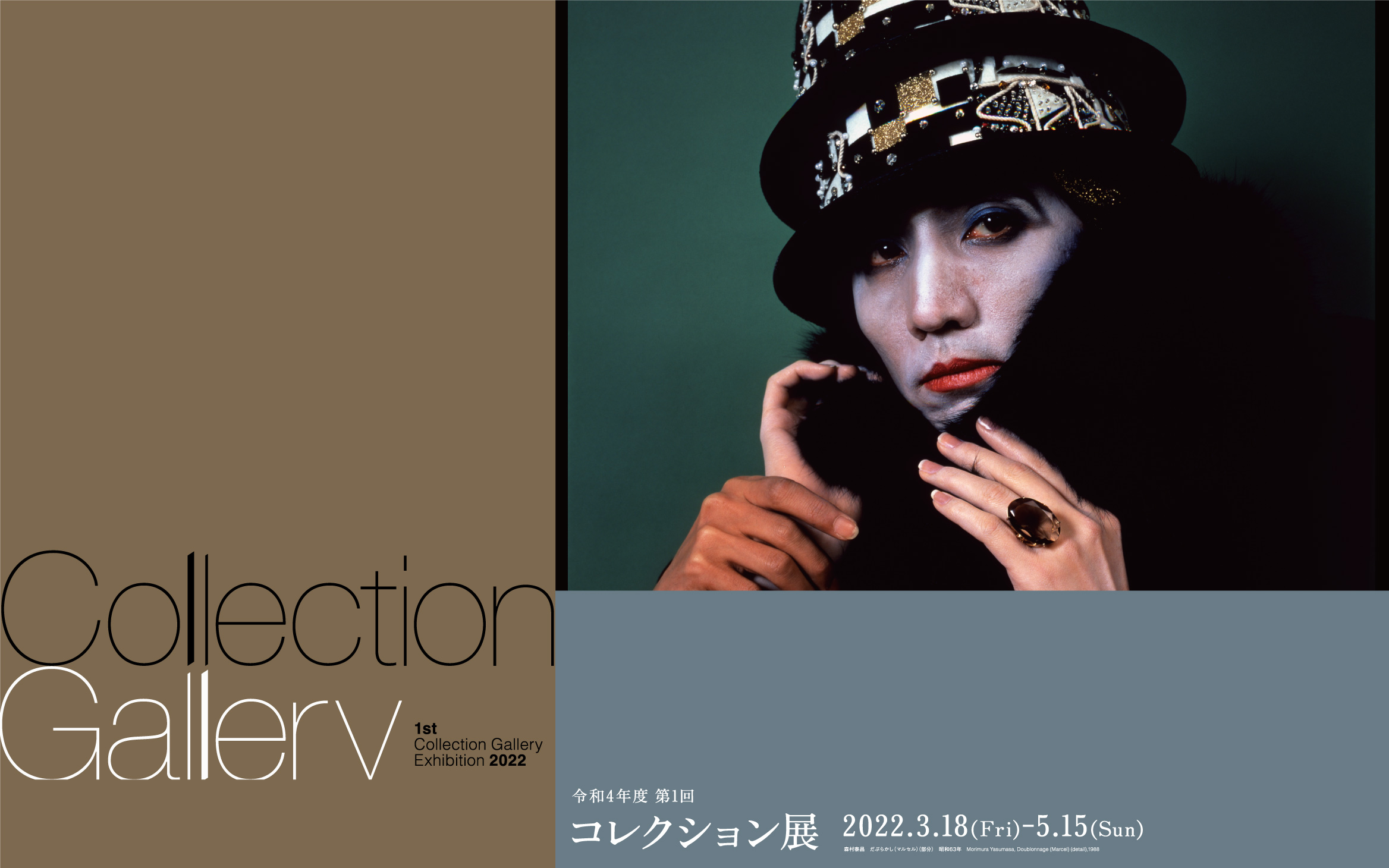
Collection Gallery
1st Collection Gallery Exhibition 2022–2023
2022.03.18 fri. - 05.15 sun.
Dialogue in a Room of Mirrors: MORIMURA Yasumasa and Dominique GONZALEZ-FOERSTER MORIMURA Yasumasa, Doublonnage (Marcel), 1988
Currently, the solo exhibition, MORIMURA YASUMASA: My Self-Portraits as a Theater of Labyrinths, is on view at Kyoto City KYOCERA Museum of Art. It is a retrospective of works by contemporary artist Morimura Yasumasa, who has a strong connection to our museum. With Osaka as his place of activity since the 1980s, Morimura is known for his series of self-portrait photographs using his own body to simulate famous Western paintings or personages. His many works, in which he plays the shape-shifting role with humor irrespective of gender or race, have garnered high praise and overwhelming popularity in both Japan and overseas. The National Museum of Modern Art, Kyoto has introduced Morimura's works on various occasions through its Collection exhibitions and the 1990 Images in transition: photographic representation in the eighties exhibition; the 1998 Morimura Yasumasa: Self-Portrait as Art History; and the 2018 Project related to the Van Gogh & Japan exhibition.
Dominique Gonzalez-Foerster hails from Strasbourg, France, and since the 1990s has produced installations and video works taking her ideas from literature, film, architecture, and history. In 2002 she was awarded the Marcel Duchamp Prize. In recent years, she has transformed herself into characters from novels or films to give lecture-performances that combine text and music. For her 2013 lecture-performance in Kyoto she disguised herself as Scarlett O'Hara. The costume she wore was the one Morimura Yasumasa had used for his photographic piece impersonating Vivian Leigh. From this instance of lending and borrowing the costume, Morimura and Gonzalez-Foerster started their association.
A commonality can be seen in the creative activity of these two artists who examine identity and transformation. On Gonzalez-Foerster’s series Tapis de lecture (Carpet for Reading), Morimura interpreted it schematically as “the carpet = the writer’s body; the pile of books = the soul of the writer,” and has pronounced it to be “Dominique’s version of a ‘portrait in absentia’.” Gonzalez-Foerster has praised Morimura for “showing the world his technique to delve into issues entangled with identity and existence.” Do the artists exist in the works exhibited here? We may be able to hear the murmurs of their voices from somewhere.
Western-style Painting in the Kyoto-Osaka Region KOIDE Narashige, Female Nude, 1925
The history of modern Japanese art tends to focus on the artists who were active in Tokyo. However, modern Japan was not always centered solely in Tokyo. In fact, Osaka, with its expansion of urban life based on private railway networks flourished in a different way from Tokyo. By the mid-1920s, Osaka had become the largest city in Japan, outstripping Tokyo, and was called "Dai Osaka" (Big Osaka). From early on, multiple private railways constructed transportation networks, with the business region tying Kyoto and Kobe, eventually spreading to Nara and Ise. It may be said that this expansion nurtured a rich, unique culture of the Kyoto-Osaka region, in which cutting edge scientific technology and fashionable Western-style food, clothing, and housing blended with ancient performing arts and the romance of myths. This modern culture of the Kyoto-Osaka-Kobe region was evident in its fine art as well.
Among the Western-style painters of oil and watercolor who were based in the Kansai region, Koide Narashige is often cited as an artist who symbolized the modern culture of the area. Born into a merchant family in Osaka, he was familiar with traditional culture. After studying abroad in France, he lived a Western lifestyle in Ashiya. He kept his distance from Tokyo's painting establishment, eschewed trendiness, included classical Western art in his perspective, and excelled in literary writings alongside his paintings. In this he was like Suda Kunitaro and Kuroda Jutaro of Kyoto. Koide and Kuroda, together with Nabei Katsuyuki and Kunieda Kinzo, participated in founding the Shinanobashi Oil Painting Institute in Osaka. This institute trained many painters in an amicable atmosphere of a club or salon of close-knit artists. The fact that the institute was a private art education establishment conveys the "people's city" characteristic of the Kyoto-Osaka-Kobe modern cultural sphere.
Educational Studies 03: Listening with Eyes and Looking with Ears | NAKAMURA Yuta feels his way to KAWAI Kanjiro KAWAI Kanjiro, Ceramic Sculpture, Splashed Three-color Glaze, 1962
Through “Opening the Senses: Project to Promote Innovative Art Appreciation Programs,” our museum is reassessing our approach to art appreciation, which has been focused on “looking,” to encompass the senses of “touching” and “listening.” In 2020, we launched the “ABC Project,” in which Artist, Blind (visually impaired persons), and Curator join together to apply their specialties to create new forms of art appreciation accessible to people with visual impairments.
In the second year of this project, we focus on Ceramic Sculpture, Splashed Three-color Glaze (1962), produced by Kawai Kanjiro (1890–1966) in his later years. Why did Kanjiro place a small sphere on top of the raised pointer finger? In this exhibit, we will use as our clue Kanjiro’s words “Life is work, work is life” (Inochi no mado (Window of Life), Nishimura Shoten, 1948) to touch upon Kanjiro’s way of life in order to gain an understanding of his design sensibility.
Kanjiro engaged in his daily work while surrounded by furniture and beloved objects that he designed, listening to his transistor radio, clipping newspaper articles on machines, Buddhist sculptures, Western paintings, architecture, children’s poems, medicines, and such to insert into his diary. From his phrase “listen with eyes and look with ears,” we can imagine him taking shapes in nature and machine products close at hand, blending and harmonizing them within his body to create his free form designs.
The exhibit space is set with newspaper articles clipped by Kanjiro, Yasuhara Rie’s audio recordings of touching objects in Kawai Kanjiro’s House, and Nakamura Yuta’s designed objects based on those experiences. In this space, using the senses of “touching” and “listening,” we will be able to decipher from a new perspective how Kanjiro created his works. Related to this exhibition, you can enjoy the special website “ABC Collection Database Vol.2 Listening with Eyes and Looking with Ears - Kawai Kanjiro” (Japanese only).
Supported by: the Agency for Cultural Affairs, Government of Japan, the fiscal 2021
Special cooperation: Kawai Kanjiro’s House
The Colors of Ceramics KAWAI Kanjiro, Long-necked Bottle, Copper Red Glaze, c. 1921
The works of Kawai Kanjiro draw us to them through the free forms seen in the ceramic sculptures of his later years and the sense of ease in his patterns. At the same time, just as his friend Yanagi Soetsu (Muneyoshi) described Kawai’s unique quality of “colors,” his expression through glazes stood out. In this exhibit, with our attention on “Educational Studies 03: Listening with Eyes and Looking with Ears,” we focus particularly on works like those by Kanjiro that delve into the expression of the color of glazes.
Glaze refers to the thin glass-like layer that covers the surface of a ceramic vessel. In applying glaze, in the case of transparent glaze, it is used to show the color of the clay, as in porcelain. Underglaze colors, such as underglaze blue and copper red glaze, are the result of coloration using cobalt pigment or copper oxide. Three-color glaze and monochrome glaze colors of green, yellow, and black are examples of colorations of glazes in themselves. Celadon is a glaze that contains iron, which produces a wide range of color tones. The minute air bubbles in the glaze give off a diffuse reflection of light, allowing for depth in the color. As glazes have a thickness, the coloration that one can see changes depending on the reflected light, just as the intensity of color depends on the depth of the water. Changes due to cracks called crackling (kannyu), crystallization, and fluidity occur during firing and cooling, and have been the object of ceramic appreciation. When the surface of the glaze is drawn upon and refired, the upper layer pigment color turns into the surface color.
After graduating from Tokyo Higher Technical School (now Tokyo Institute of Technology), in 1914 Kawai Kanjiro joined the Kyoto City Ceramic Research Institute as a technician and engaged in the study of glazes. He was among the first generation of ceramic artists who had systematically studied modern ceramic techniques. The Kyoto City Ceramic Research Institute was founded in 1896 as the first ceramic research organization in Japan to be established by a regional municipality. In 1920 it became a national institution. Its purpose was to publicize specialized knowledge and support the tests and trial productions of the region’s artists. Artists who received training there included Uno Soyo I. In 1911, the attached training institute was established, at which Kawai Einosuke, Yagi Isso, Kusube Yaichi, Shimizu Uichi, and others studied.
Through the study of glazes, these artists deepened their understanding of color expression, which became an approach to their production while developing their own style of creation.
Stationery Goods as Seen in Modern Craft Arts KAMISAKA Sekka, Paulownia Wood Box for Shikishi and Strip, Kazan-in Style, c. 1920-26
The origin of the term bunbogu (Chinese: wenfangju) can be traced back to China’s Northern and Southern Dynasties period (439-589). At that time the study where Chinese literati read books or wrote items was called bunbo (Chinese: wenfang), and the cherished tools they used there were called bunbogu. In addition to stationery goods, the term included artworks such as paintings, calligraphy, and ceramics, as well as musical instruments such as the koto (Chinese: qin). From the Song Dynasty (960–1279), the main stationery goods became what were called the “four stationery treasures” or “four friends”: inkstone, brush, ink, and paper. Today, the lineages of past Chinese and early modern Japanese literati have nearly become extinct, and opportunities to write with a brush are much fewer. This means that stationery goods featuring inkstone, brush, ink, and paper are largely remote from our present-day lifestyle. It has been said that, even in the past, these items had more of an impact as objects of appreciation than their functional usage. Stationery goods made of modern craft arts are truly functional objects that include the feature of appreciation that imply the originality of the creator in their designs and forms.
Akatsuka Jitoku’s Writing Paper Box and Inkstone Box with Design of Cherry Blossoms, Maki-e is decorated with the imperial chrysanthemum crest on the underside of the lid, suggesting that it was presented to the Imperial household. The lid is covered by a thin sheet of silver on which a lacquerware design has been incised, giving the work a very stiff textural quality. The works by Koda Shuetsu and Tsuishu Yozei XX employ the elaborate details of the techniques of makie (gold-leaf lacquerware) and tsuishu (carving on layered red lacquer), while Takeuchi Hekigai’s inkstone box combines different species of wood to give his design an ornate quality. Kamisaka Sekka’s work in which a crane elegantly takes flight is full of refinement, whereas Shimizu Nanzan’s singular motif of arm wrestling is set off by the blank space around the main subject, exuding a spirituality reminiscent of Shinto rituals. Kawai Kanjiro was absorbed in producing ceramic inkstones for a time, to the point of holding a solo exhibit solely on those works. The diverse glazes and techniques that he made use of in his forms superbly fuse together his joy of creation with functionality and originality.
Selected Works of Western Modern Art
In this corner, we display excellent works of Western modern art from the holdings and deposited works in our museum. For this exhibition, we have collected representations of flowers in vases and glasses.
It was from the sixteenth to the seventeenth centuries that paintings of flowers gained an independent status in still lifes in Western art history. With the rise of Protestants who were averse to artwork within churches, wealthy citizens became the new patrons of art in place of the church. Their preference for everyday subjects promoted the flourishing of still lifes, and the approachable beauty of flowers became a central motif. However, because flowers wither after they bloom, these paintings also functioned as vanitas paintings of lessons in the mortality of living beings. By the mid-nineteenth century, with the rise of realism as represented by Courbet and the further expansion of the bourgeoisie, still lifes and landscapes depicting scenes familiar to the viewer became popular, erasing the aspect of lessons in mortality from still lifes. For modern painters who were interested in the composition of paintings, the still life was a form in which they could freely arrange their subject according to their intentions. It was a fitting theme for experimentation in pursuit of expression of pure color and form without dependence on the subject.
In the work by Henri-Jean Theodore Fantin-Latour, popular as the "still life artist of flowers," the realistic depiction of carnations appears against a dark background, while the outline of the vase is vague, as if to melt into the background. Only the foot of the vase catches the light in response to the brilliance of the flowers. This lends a tension which belies the lustrous ornamentation of the painting surface. Pierre Auguste Renoir, known for his sweet and voluptuous female figures, also painted many still lifes of flowers. This work on display uses energetic brush strokes to depict a bouquet of roses that fills the entire surface of the painting. The powerful life force in this work relates to the female nudes that he painted. He is quoted as saying he applied the color tonalities that he used in his paintings of flowers to his paintings of human figures.
The work by Maurice de Vlaminck, a central figure in the Fauvism movement who influenced Saeki Yuzo and Satomi Katsuzo, clearly shows that depicting flowers was a way to experiment with color and form. Flowers placed in a simple vase are drawn with rapid, vigorous brush strokes. Nothing is painted in the background, with only the various color tonalities of the flowers and vase expanding outward. This type of painting of flowers by Vlaminck was highly praised for "its wild material being wrapped in the allure of miraculous color tonality."
Vlaminck drew many paintings of wildflowers that he picked from his garden. Another artist who drew wildflowers as a central motif was Hasegawa Kiyoshi, who was active in Paris. Hasegawa is known for his tranquil and symbol-laden maniere noire mezzotint works, but alongside his prints he also worked all his life on oil paintings. Here, also, the background is a horizontal line that indicates the edge of the table, but above it is only a subtle color of similar tones shown in the flowers. This emphasizes the intricate diagonal composition and frontality indicated by the transparent, bright colors of volubilis (a type of morning glory) and other flowers, branches and leaves. It makes clear that this work, while aiming for executing modern colors and forms, inherits the tradition of seventeenth century Dutch paintings of flowers and plants.
Exhibition Period
2022.03.18 fri. - 05.15 sun.
Themes of Exhibition
Dialogue in a Room of Mirrors: MORIMURA Yasumasa and Dominique GONZALEZ-FOERSTER
Western-style Painting in the Kyoto-Osaka Region
Educational Studies 03: Listening with Eyes and Looking with Ears | NAKAMURA Yuta feels his way to KAWAI Kanjiro
The Colors of Ceramics
Stationery Goods as Seen in Modern Craft Arts
Selected Works of Western Modern Art
[Outside] Outdoor Sculptures
List of Works
1st Collection Gallery Exhibition 2022–2023 (85 works in all) (PDF)
Free Audio Guide App
How to use Free Audio Guide (PDF)
Hours
9:30AM–5:00PM
*Fridays and Saturdays: 9:30AM–8:00PM
*Admission until 30 min. before closing
*Opening hours is subject to change, due to the prevention against COVID-19 pandemic. Please check the updated information, before your visit.
Admission
Adult: 430 yen (220 yen)
University students: 130 yen (70 yen)
High school students or younger,seniors (65 and over): Free
*Figures in parentheses are for groups of 20 or more.
*This ticket is only available at Collection Gallery.
Collection Gallery Free Admission Days
March 19, May 14, 2022
Free Audio Guide App How to use Free Audio Guide (PDF)



